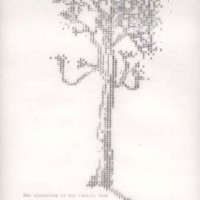TypeSet
Materials:
Typewriters, steel and tracing film
Concept:
TYESET was a public art installation conceived by Tricia Flanagan in an artist in residence project funded by the Palai Royal Youth Venue in Newcastle Australia. The project involved working with youth to create a site-specific installation in the Playhouse Theatre for the Australian National Playwrights Conference.
Typewriters were the theme of the exhibition; they were collected and donated to the project. The typewriter is a reminder of days of less visual literacy, when technology dictated the limits of textual communications – most people did not have a choice of fonts or text size, these things were left for the professional. Today the typewriter font itself is understood typographically to be old fashion or retro.
The typewriter offers a way to communicate with a raw tactility that has been lost to the professional gloss of the computergenerated page. A typewritten text gives away a lot about the individual character of the machine and the operator – the pressure of the fingers, the stamping of the ink. The sounds the machine makes in use, the rhythm that this mechanical instrument plays. There is a mechanical logic in machinery of the industrial age that does not exist in digital logic.
‘Before the industrial revolution the universe had not been atomised or broken down into mechanical parts and the city had been viewed as an eco-system, almost a living organism. The machine city is pre-occupied with output; a future state. Speed is an attempt to beat time and bring the future forward. It reinforces our future-orientated ‘mode of becoming’ because the focus of the journey is the activity (yet in the future), which we are rushing into, speed also destroys the opportunity to experience the immediate moment and divorces us from place.’21
A strong emphasis of the project workshops was on experimentation, through exploration the artworks evolved, responding to the surroundings, to the interaction of the public, the history of the space and the theme, the conceptual frameworks and the perception of others. Typewriters were dismantled and reassembled.
For this exhibition Flanagan creates an interactive sculpture in the foyer space of the civic playhouse. A typewriter, mounted on a high table, is loaded with a seemingly endless length of paper that runs from the typewriter through a series of rollers, the paper drapes from floor to ceiling repeatedly, working with the architecture of the space, displaying what has been typed over the period of the exhibition, a visible and ongoing story, eclectic poetry; a collection of the thoughts and images that have been typed. The typewriter has no delete key unlike modern word processing. What is written stays; it is evidence – a trace, a memory recording the thoughts and ideas of everyone who put their fingers to the keys.
The seemingly endless band, features pictures and portraits created on the typewriter from typed fonts, they link poetic narratives dispersed between words, read as lines of a story. The ongoing narrative is generated by groups of people contributing spontaneous thoughts, the thoughts and ideas document a moment in time, a collective memory.
Information technology – word processing, emails and text messages have changed the way we use the written word, information technology enables structures to function that are informal and fluid, more like speech, but developing and evolving with their own particular nuances and attributes.
Project partners:
Civic Playhouse, Australian National Playwrites Conference (ANPC), The Palais Royal Youth Venue, TAFE Design Students and The University of Newcastle.
Exhibition:
Civic Playhouse, Australian National Playwrites Conference (ANPC) 19 June to 3rd July, 2005.
Thanks:
Funding by Palais Royal Youth Venue, with generous support from Daniel Ballantine, Barney Langford, Bindi Booth, Jessica Brennan, Madeleine Caruana, Donnah Carroll, Jessica Gilbert, Jane Hamilton, Blair Makin, Carlena Payne and Benjamin Peters.
Endnotes:
21. ENGWICHT, D. (1992) Towards an eco-city : calming the traffic, Sydney, Envirobook. P. 26.




